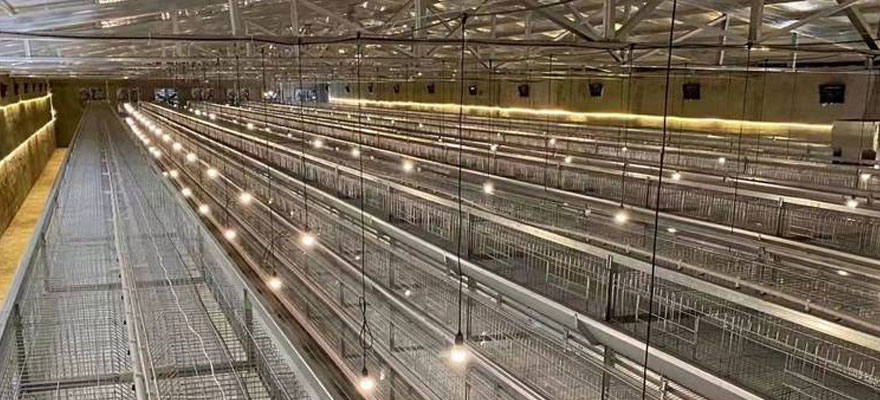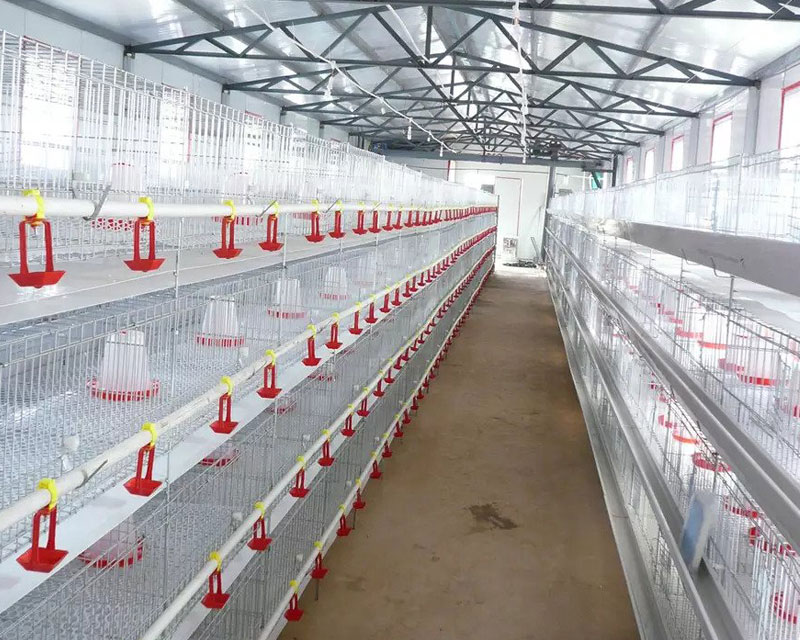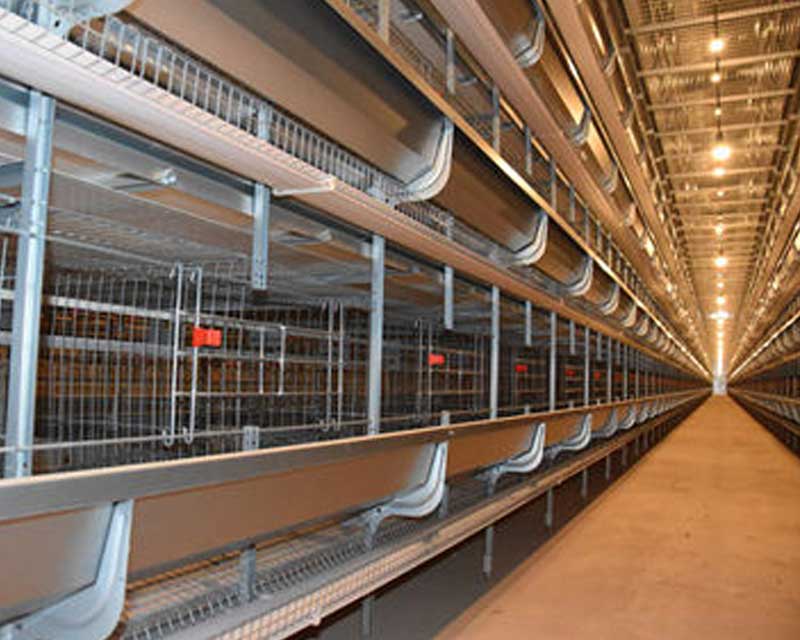A Comprehensive Guide To The Battery Cage System In Poultry
Introduction
The battery cage system is a type of housing used in the commercial production of eggs. It involves confining hens in small wire cages, with several cages stacked on top of each other in rows. While the system has been in use for decades and is still widely used in many countries, it has become increasingly controversial due to ethical concerns and animal welfare issues.

Historical context and development of the system
Battery cages were first introduced in the 1950s as a way to increase egg production efficiency and reduce costs. The cages were designed to provide a controlled environment for hens, with automated feeding and watering systems and waste collection systems. This allowed farmers to keep more hens in a smaller space, resulting in higher egg production.
Controversy surrounding the use of battery cages
The use of battery cages has been a subject of controversy and debate for many years. Animal welfare advocates and many consumers believe that the cages are inhumane and cruel, as they do not allow hens to engage in natural behaviors such as nesting, perching, or dust-bathing. There are also concerns about the cramped living conditions in battery cages, which can lead to stress, injury, and disease among hens.
This article will provide a comprehensive overview of the battery cage system, including its advantages and disadvantages, alternative housing systems, and the controversy surrounding its use. By examining the various perspectives and arguments surrounding the use of battery cages, we aim to provide readers with a balanced and informative guide to this important topic.
The Advantages of Battery Cages

Despite the controversy surrounding their use, battery cages offer several advantages for commercial egg production. Here are some of the main benefits:
Improved biosecurity and hygiene
Battery cages provide a controlled environment for hens, which can help reduce the spread of diseases and parasites. The wire mesh floors of the cages also allow for easier cleaning and disinfection, which can help maintain a higher level of hygiene and cleanliness.
Increased egg production and profitability
Battery cages are designed to maximize egg production by allowing farmers to keep a large number of hens in a relatively small space. This means that they can produce more eggs per square foot of space, resulting in higher profits for the farmer.
Reduced labor costs
The automated feeding and watering systems used in battery cages can reduce labor costs for farmers. With fewer manual tasks to perform, farmers can save time and money on labor expenses.
Better egg quality
Because battery cages provide a controlled environment for hens, they can help ensure that the eggs are of consistent quality. The eggs are less likely to be cracked, soiled, or contaminated, which can lead to higher prices and increased consumer demand.
While there are certainly concerns about the ethical and animal welfare implications of using battery cages, it is important to acknowledge that they do offer some benefits for farmers and the egg industry.
The Disadvantages of Battery Cages
Despite the benefits of the battery cage system for commercial egg production, there are also several significant disadvantages associated with its use. Here are some of the main drawbacks:
Ethical concerns: Battery cages are widely criticized by animal welfare advocates and many consumers for their inhumane treatment of hens. The cages are small and confining, preventing hens from engaging in natural behaviors such as nesting, perching, and dust-bathing.
Health and welfare issues for chickens: The cramped living conditions in battery cages can lead to a range of health and welfare issues for hens. These can include stress, injuries, disease, and skeletal problems.
Environmental concerns: The high density of hens in battery cages can lead to environmental problems, including waste management issues and pollution. The disposal of manure from battery cage facilities can be a major source of air and water pollution, which can have negative impacts on human and animal health.
Lower quality of life for farmers: The use of battery cages can also have negative impacts on the quality of life for farmers who work with them. The physical demands of working with the cages can lead to injuries and health problems, and the high-density living conditions can also increase the risk of disease transmission among workers.
In light of these concerns, many advocates have called for the phasing out of battery cages in favor of alternative housing systems that prioritize animal welfare and environmental sustainability.
Alternatives to Battery Cages

As concerns about the ethical and animal welfare implications of battery cages have grown, many farmers and egg producers have begun to explore alternative housing systems for hens. Here are some of the most common alternatives:
Free-range systems: Free-range systems allow hens to roam outside in a designated outdoor area, providing them with access to natural sunlight, fresh air, and space to move around. This system is often viewed as a more humane and natural alternative to battery cages, but it can also be more costly and labor-intensive for farmers.
Enriched colony cages: Enriched colony cages are larger and more spacious than traditional battery cages, providing hens with more room to move around and engage in natural behaviors. They also include perches, nesting areas, and scratching areas, which can help improve hen welfare. However, some animal welfare advocates argue that these cages still do not provide adequate space and freedom of movement for hens.
Cage-free systems: Cage-free systems allow hens to roam freely inside a barn or other indoor area, providing them with more space and freedom of movement than traditional battery cages. However, they can also be more challenging to manage in terms of biosecurity and waste management, and they may also be more costly for farmers to implement.
Comparison of alternative systems
Each of these alternative housing systems has its own advantages and disadvantages, and the best choice will depend on the specific needs and priorities of each farmer or egg producer. Factors to consider may include cost, labor requirements, animal welfare concerns, environmental sustainability, and consumer demand. Ultimately, the goal of these alternative systems is to provide hens with a better quality of life while also ensuring the economic viability of the egg industry.
Conclusion
In conclusion, the battery cage system has been a widely used and controversial method of commercial egg production for many years. While it offers several advantages, including improved biosecurity and increased profitability, it also raises significant ethical, animal welfare, and environmental concerns.
As a result, many farmers and egg producers have begun to explore alternative housing systems for hens, such as free-range systems, enriched colony cages, and cage-free systems. These systems offer a more humane and sustainable approach to egg production, but they also come with their own set of advantages and disadvantages.
FAQ
What is the difference between battery cages and free-range systems?
Battery cages are small wire cages that house multiple hens, providing limited space for movement and limited access to natural light and fresh air. Free-range systems, on the other hand, allow hens to roam outside in a designated outdoor area, providing them with access to natural sunlight, fresh air, and space to move around.
Why are battery cages controversial?
Battery cages are controversial due to concerns about the ethical treatment of hens, including limited space, restricted movement, and lack of access to natural light and fresh air. There are also concerns about environmental sustainability, animal welfare, and food safety.
What are enriched colony cages?
Enriched colony cages are a larger and more spacious alternative to traditional battery cages, providing hens with more space to move around and engage in natural behaviors. These cages include perches, nesting areas, and scratching areas, which can help improve hen welfare.
How do environmental concerns relate to the use of battery cages?
Environmental concerns related to battery cages include waste management, water usage, and greenhouse gas emissions. Battery cage systems produce significant amounts of manure, which can contribute to water pollution and greenhouse gas emissions if not managed properly.
Do battery cages affect the quality of the eggs?
Battery cages can impact egg quality if hens are stressed or experience health problems due to limited space and movement. However, the quality of the eggs can also depend on other factors, such as the diet and age of the hens.
What are the welfare concerns surrounding battery cages?
Welfare concerns related to battery cages include limited space, restricted movement, and lack of access to natural light and fresh air. Hens in battery cages may also experience health problems and stress due to overcrowding and unsanitary conditions.
What are some countries that have banned the use of battery cages?
Several countries have banned or restricted the use of battery cages, including Switzerland, Germany, Austria, and the Netherlands.
Are there any health risks associated with consuming eggs from battery cages?
There are no significant health risks associated with consuming eggs from battery cages, as long as they are properly washed and cooked. However, some consumers may have ethical concerns about supporting a system that is viewed as inhumane and unsustainable.
Are there any benefits to the farmer when using alternative systems?
Alternative systems can provide farmers with a competitive advantage by meeting consumer demand for more ethical and sustainable egg production methods. Additionally, some alternative systems, such as free-range systems, can improve soil health and reduce the need for chemical fertilizers.
Is it possible for large-scale egg production to exist without battery cages?
Yes, it is possible for large-scale egg production to exist without battery cages. Alternative systems such as free-range systems, enriched colony cages, and cage-free systems can provide hens with a better quality of life while also ensuring the economic viability of the egg industry. However, these systems may also require more resources and investment from farmers.

 4 Tier H Type Broiler Cage Project In South Africa
4 Tier H Type Broiler Cage Project In South Africa Layer Cage Project In Cuba
Layer Cage Project In Cuba H Type Layer Cage Project In Southeast Asia
H Type Layer Cage Project In Southeast Asia A Type Layer Cage Installed In West Africa
A Type Layer Cage Installed In West Africa Nigeria H Type Layer Cage Project
Nigeria H Type Layer Cage Project H Type Layer Cage Installed In Togo
H Type Layer Cage Installed In Togo